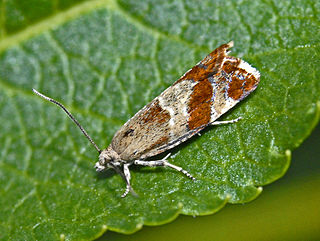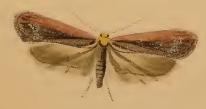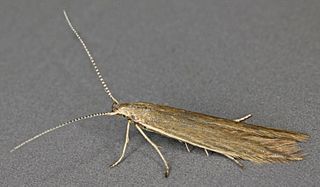
The luna moth, also called the American moon moth, is a Nearctic moth in the family Saturniidae, subfamily Saturniinae, a group commonly named the giant silk moths.

The cinnabar moth is a brightly coloured arctiid moth found as a native species in Europe and western and central Asia then east across the Palearctic to Siberia to China. It has been introduced into New Zealand, Australia and North America to control ragwort, on which its larvae feed. The moth is named after the red mineral cinnabar because of the red patches on its predominantly black wings. The species was first described by Carl Linnaeus in his 1758 10th edition of Systema Naturae. Cinnabar moths are about 20 mm (0.79 in) long and have a wingspan of 32–42 mm (1.3–1.7 in).

The Pyralidae, commonly called pyralid moths, snout moths or grass moths, are a family of Lepidoptera in the ditrysian superfamily Pyraloidea. In many classifications, the grass moths (Crambidae) are included in the Pyralidae as a subfamily, making the combined group one of the largest families in the Lepidoptera. The latest review by Eugene G. Munroe and Maria Alma Solis retain the Crambidae as a full family of Pyraloidea.

Eacles imperialis, the imperial moth, is a member of the family Saturniidae and subfamily Ceratocampinae. It is found mainly in the East of South America and North America, from the center of Argentina to south Canada. The species was first described by Dru Drury in 1773.

Samia cynthia, the ailanthus silkmoth, is a saturniid moth, used to produce silk fabric but not as domesticated as the silkworm, Bombyx mori. The moth has very large wings of 113–125 mm (4.4–4.9 in), with a quarter-moon shaped spot on both the upper and lower wings, whitish and yellow stripes and brown background. There are eyespots on the outer forewings. The species was first described by Dru Drury in 1773.

Macaria brunneata, the Rannoch looper, is a moth of the family Geometridae. The species was first described by Carl Peter Thunberg in 1784. It is found in Siberia, Japan, and northern and mountainous parts of North America, and throughout Europe, though in Britain it is largely or entirely restricted to mature forests in central Scotland.

Argyresthia goedartella, the bronze alder moth, is a species of moth of the family Argyresthiidae.

Emmelina monodactyla is a moth of the family Pterophoridae found in Africa, Asia, Europe and North America. It was first described by Carl Linnaeus in 1758.

The hemlock moth, also known as the defoliating hemlock moth or poison hemlock moth, is a nocturnal moth species of the family Depressariidae. Of Palaearctic origin, it was first found in North America in 1973 when it was accidentally introduced. The moth is now widespread throughout the northern half of the United States, southern Canada, northern Europe, and, more recently, New Zealand and Australia. The larval form grows to around 10 mm, while the adults wingspan is between 17 mm and 19 mm.

Epinotia cruciana, the willow tortrix, is a moth of the family Tortricidae.

Anthanassa frisia, the Cuban crescentspot, Cuban checkerspot or Cuban crescent, is a butterfly of the family Nymphalidae. Subspecies tulcis is known by the common names pale-banded crescent or Tulcis crescent; it is treated as a species by some authors.

Lampronia corticella, the raspberry moth, is a moth of the family Prodoxidae. The species was first described by Carl Linnaeus in his 1758 10th edition of Systema Naturae. It is found in most of Europe, except Iceland, the Iberian Peninsula and the Balkan Peninsula. It is an introduced species in North America, where it was first detected in New Brunswick, Canada, in 1936.

Misogada is a monotypic moth genus of the family Notodontidae erected by Francis Walker in 1865. Its only species, Misogada unicolor, the drab prominent, was first described by Alpheus Spring Packard in 1864. It is found in North America from Nova Scotia to Florida, west to Texas and north to Saskatchewan.

Blunt’s flat-body or purple carrot-seed moth is a moth of the family Depressariidae. It is found in most of Europe. It is also found in the Near East, North Africa, the eastern part of the Palearctic realm and since 2009 in North America.
Setomorpha is a monotypic moth genus in the family Tineidae described by Philipp Christoph Zeller in 1852. Its only species, Setomorpha rutella, the tropical tobacco moth, was described by the same author in the same year. It is a widely spread species that has been distributed by commerce over much of the warmer parts of Africa, Eurasia, Malaysia, Australia, many Pacific islands and North and South America.

Grapholita molesta, the oriental fruit moth or peach moth, is a moth of the family Tortricidae. It is native to China, but was introduced to Japan and North America and is now also found throughout of Europe, Asia and South America and in Hawaii, Morocco, Mauritius, South Africa, Australia and New Zealand

Coleophora alticolella is a moth of the family Coleophoridae, found in Europe and North America.

Epinotia trigonella, the birch epinotia moth, is a species of moth of the family Tortricidae. It is found in most of Europe, east to the eastern Palearctic realm. It is also found in North America.
Rumatha jacumba is a species of snout moth in the genus Rumatha. It was described by Herbert H. Neunzig in 1997. It is found in North America, including California and Nevada.
Rumatha glaucatella is a species of snout moth in the genus Rumatha. It was described by George Duryea Hulst in 1888. It is found in North America, including southern Texas and Florida.















